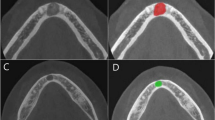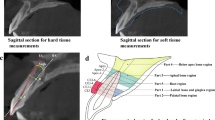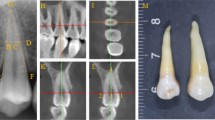Abstract
Objectives
This study aimed to quantitatively assess maxillary central incisor roots using pre-orthodontics computed tomography (CT) texture analysis as part of a radiomics quantitative analysis.
Methods
This retrospective case–control study included 16 patients with external apical root resorption (EARR) and 16 age- and sex-matched patients without EARR, after orthodontic treatment who underwent pre-orthodontics CT for jaw deformities. All patients were treated with a fixed orthodontic appliance before and after surgical orthodontic treatment. EARR was defined as root resorption ≥ 2 mm of the left and right maxillary central incisors on CT images more than 2 years after the start of orthodontic treatment. Texture features of the maxillary central incisor with and without EARR after orthodontic treatment were analyzed using the open-access software, MaZda Ver. 3.3. Ten texture features were selected using the Fisher method in MaZda from 279 original parameters, which were calculated for each of the maxillary central incisors with and without EARR. The results were tested using the Student’s t test, Welch’s t test, or Mann–Whitney U test.
Results
Four gray-level run length matrix features and six gray-level co-occurrence matrix features displayed significant differences between both the groups (p < 0.01).
Conclusions
CT texture analysis was able to quantitatively assess maxillary central incisor roots and distinguish between maxillary central incisor roots with and without EARR. CT texture analysis may be a useful method for predicting EARR after orthodontic treatment.


Similar content being viewed by others
References
Pizzo G, Licata ME, Guiglia R, Giuliana G. Root resorption and orthodontic treatment. Review of the literature. Minerva Stomatol. 2007;56:31–44.
Lopatiene K, Dumbravaite A. Risk factors of root resorption after orthodontic treatment. Stomatologija. 2008;10:89–95.
Weltman B, Vig KW, Fields HW, Shanker S, Kaizar EE. Root resorption associated with orthodontic tooth movement: a systematic review. Am J Orthod Dentofacial Orthop. 2010;137:462–76 (discussion 12A).
Roscoe MG, Meira JB, Cattaneo PM. Association of orthodontic force system and root resorption: a systematic review. Am J Orthod Dentofac Orthop. 2015;147:610–26.
Yi J, Li M, Li Y, Li X, Zhao Z. Root resorption during orthodontic treatment with self-ligating or conventional brackets: a systematic review and meta-analysis. BMC Oral Health. 2016;16:125.
Elhaddaoui R, Qoraich HS, Bahije L, Zaoui F. Orthodontic aligners and root resorption: a systematic review. Int Orthod. 2017;15:1–12.
Jacob A, Shetty S, Nambiar S, Jose NP. A literature review on orthodontically induced root resorption: the aftermath of the pursuit of an attractive smile. Eur J Mol Clin Med. 2020;7:941–57.
Gay G, Ravera S, Castroflorio T, Garino F, Rossini G, Parrini S, et al. Root resorption during orthodontic treatment with Invisalign®: a radiometric study. Prog Orthod. 2017;18:12.
Lambin P, Rios-Velazquez E, Leijenaar R, Carvalho S, van Stiphout RG, Granton P, et al. Radiomics: extracting more information from medical images using advanced feature analysis. Eur J Cancer. 2012;48:441–6.
Avanzo M, Stancanello J, El Naqa I. Beyond imaging: the promise of radiomics. Phys Med. 2017;38:122–39.
Valdora F, Houssami N, Rossi F, Calabrese M, Tagliafico AS. Rapid review: radiomics and breast cancer. Breast Cancer Res Treat. 2018;169:217–29.
Gao J, Jiang Q, Zhou B, Chen D. Convolutional neural networks for computer-aided detection or diagnosis in medical image analysis: an overview. Math Biosci Eng. 2019;16:6536–61.
Gentillon H, Stefańczyk L, Strzelecki M, Respondek-Liberska M. Parameter set for computer-assisted texture analysis of fetal brain. BMC Res Notes. 2016;9:496.
Lazli L, Boukadoum M, Ait Mohamed O. Computer-aided diagnosis system of Alzheimer’s disease based on multimodal fusion: tissue quantification based on the hybrid fuzzy-genetic-possibilistic model and discriminative classification based on the SVDD model. Brain Sci. 2019;9:e289.
Liu R, Li H, Liang F, Yao L, Liu J, Li M, et al. Diagnostic accuracy of different computer-aided diagnostic systems for malignant and benign thyroid nodules classification in ultrasound images: a systematic review and meta-analysis protocol. Medicine (Baltimore). 2019;98:e16227.
Mosquera-Lopez C, Agaian S, Velez-Hoyos A, Thompson I. Computer-aided prostate cancer diagnosis from digitized histopathology: a review on texture-based systems. IEEE Rev Biomed Eng. 2015;8:98–113.
Barry B, Buch K, Soto JA, Jara H, Nakhmani A, Anderson SW. Quantifying liver fibrosis through the application of texture analysis to diffusion weighted imaging. Magn Reson Imaging. 2014;32:84–90.
de Carvalho Alegro M, Valotta Silva A, Yumi Bando S, de Deus Lopes R, Martins de Castro LH, Hungtsu W, et al. Texture analysis of high resolution MRI allows discrimination between febrile and afebrile initial precipitating injury in mesial temporal sclerosis. Magn Reson Med. 2012;68:1647–53.
Fujimoto K, Tonan T, Azuma S, Kage M, Nakashima O, Johkoh T, et al. Evaluation of the mean and entropy of apparent diffusion coefficient values in chronic hepatitis C: correlation with pathologic fibrosis stage and inflammatory activity grade. Radiology. 2011;258:739–48.
Jirák D, Dezortová M, Taimr P, Hájek M. Texture analysis of human liver. J Magn Reson Imaging. 2002;15:68–74.
Mayerhoefer ME, Stelzeneder D, Bachbauer W, Welsch GH, Mamisch TC, Szczypinski P, et al. Quantitative analysis of lumbar intervertebral disc abnormalities at 3.0 tesla: value of t(2) texture features and geometric parameters. NMR Biomed. 2012;25:866–72.
Risse F, Pesic J, Young S, Olsson LE. A texture analysis approach to quantify ventilation changes in hyperpolarised 3He MRI of the rat lung in an asthma model. NMR Biomed. 2012;25:131–41.
Buch K, Fujita A, Li B, Kawashima Y, Qureshi MM, Sakai O. Using texture analysis to determine human papillomavirus status of oropharyngeal squamous cell carcinomas on CT. AJNR Am J Neuroradiol. 2015;36:1343–8.
Fujita A, Buch K, Li B, Kawashima Y, Qureshi MM, Sakai O. Difference between HPV-positive and HPV-negative non-oropharyngeal head and neck cancer: texture analysis features on CT. J Comput Assist Tomogr. 2016;40:43–7.
Kuno H, Qureshi MM, Chapman MN, Li B, Andreu-Arasa VC, Onoue K, et al. CT texture analysis potentially predicts local failure in head and neck squamous cell carcinoma treated with chemoradiotherapy. AJNR Am J Neuroradiol. 2017;38:2334–40.
Levander E, Malmgren O, Eliasson S. Evaluation of root resorption in relation to two orthodontic treatment regimes. A clinical experimental study. Eur J Orthod. 1994;16:223–8.
Szczypinski P, Strzelecki M, Materka A. MaZda—a software for texture analysis. In Proceedings of ISITC, vol 2007, November 23–23, 2007. South Korea; 2007: 245–9
Strzelecki M, Szczypinski P, Materka A, Klepaczko A. A software tool for automatic classification and segmentation of 2D/3D medical images. Nucl Instrum Methods Phys Res A. 2013;702:137–40.
Szczypiński PM, Strzelecki M, Materka A, Klepaczko A. MaZda-A software package for image texture analysis. Comput Methods Programs Biomed. 2009;94:66–76.
Haralick RM, Shanmugam K, Dinstein I. Textural features for image classification. IEEE Trans Syst Man Cybern. 1973;SMC-3:610–21.
Ito K, Muraoka H, Hirahara N, Sawada E, Okada S, Kaneda T. Quantitative assessment of normal submandibular glands and submandibular sialadenitis using CT texture analysis: a retrospective study. Oral Surg Oral Med Oral Pathol Oral Radiol. 2021;132:112–7.
Castellano G, Bonilha L, Li LM, Cendes F. Texture analysis of medical images. Clin Radiol. 2004;59:1061–9.
Mohanaiah P, Sathyanarayana P, GuruKumar L. Image texture feature extraction using GLCM approach. Int J Sci Res Publ. 2013;3:2250–3153.
Ito K, Kondo T, Andreu-Arasa VC, Li B, Hirahara N, Muraoka H, et al. Quantitative assessment of the maxillary sinusitis using computed tomography texture analysis: odontogenic vs non-odontogenic etiology. Oral Radiol. 2021. https://doi.org/10.1007/s11282-021-00558-y.
De Rosa CS, Bergamini ML, Palmieri M, Sarmento DJS, de Carvalho MO, Ricardo ALF, et al. Differentiation of periapical granuloma from radicular cyst using cone beam computed tomography images texture analysis. Heliyon. 2020;6:e05194.
Gonçalves BC, de Araújo EC, Nussi AD, Bechara N, Sarmento D, Oliveira MS, et al. Texture analysis of cone-beam computed tomography images assists the detection of furcal lesion. J Periodontol. 2020;91:1159–66.
Costa ALF, de Souza CB, Fardim KAC, Nussi AD, da Silva Lima VC, Miguel MMV, et al. Texture analysis of cone beam computed tomography images reveals dental implant stability. Int J Oral Maxillofac Surg. 2021;50:1609–16.
Fave X, Mackin D, Yang J, Zhang J, Fried D, Balter P, et al. Can radiomics features be reproducibly measured from CBCT images for patients with non-small cell lung cancer? Med Phys. 2015;42:6784–97.
Acknowledgements
This work was supported by JSPS KAKENHI (Grant Number JP21K17101).
Funding
This work was supported by JSPS KAKENHI Grant Number JP21K17101.
Author information
Authors and Affiliations
Corresponding author
Ethics declarations
Conflict of interest
Not applicable.
Ethics approval
This study was approved by the Ethics Committee of the University School of Dentistry (No. EC15-12–009-1).
Informed consent
The requirement to obtain written informed consent was waived for this retrospective study. All the procedures followed the guidelines of the Declaration of Helsinki, Ethical Principles for Medical Research Involving Human Subjects.
Animal statements
This article does not contain any studies with animal subjects performed by the any of the authors.
Additional information
Publisher's Note
Springer Nature remains neutral with regard to jurisdictional claims in published maps and institutional affiliations.
Rights and permissions
About this article
Cite this article
Ito, K., Kurasawa, M., Sugimori, T. et al. Risk assessment of external apical root resorption associated with orthodontic treatment using computed tomography texture analysis. Oral Radiol 39, 75–82 (2023). https://doi.org/10.1007/s11282-022-00604-3
Received:
Accepted:
Published:
Issue Date:
DOI: https://doi.org/10.1007/s11282-022-00604-3




